December 17 - 31, 2000
Feliz Navidad from Los Estados Unidos Mexicanos
(click on any picture to enlarge it)
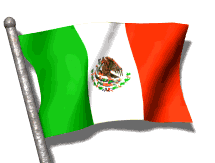
|
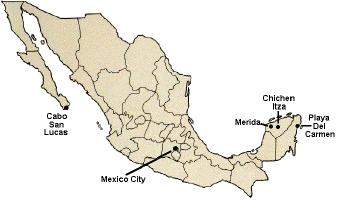
|
|
Mexico is big and exciting. It's the size of western Europe, it has a population of 95,000,000
and there are 40 Indian dialects spoken in addition to Spanish and English. Knowing that there
would be no way to do justice to the entire country in only two weeks, we "sampled" three diverse
areas: The west coast, the east coast and the capital.
We flew first to Mexico City. It's a good place to get one's bearings and change currency. (It also turned out to be a cheap round trip ticket from San Francisco.) We stayed our first two nights at Hotel Camino Real. This is a friendly, modern businessman's hotel built with dramatic Mexican architectural flare and filled with interesting art. The best part about this hotel is that you can walk across the street to Chapultepec Park and visit the wonderful Museum of Anthropology. This single museum will summarize all the pre-Columbian cultures of central America. It's a great place to start learning about Mexico. |
|
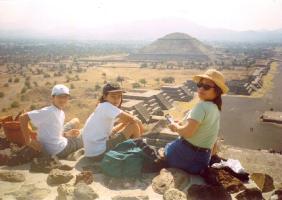 View of the Pyramid of the Sun from the top of the Pyramid of the Moon |
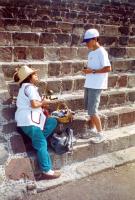 Negotiating with the locals for trinkets and souvenirs |
|
On our first full day, we hired a driver to go to see the great pyramids at
Teotihuacan. These pyramids are a "must see".
Climb the Pyramid of the Sun -- the third largest pyramid in the world. The view from the top is
stunning and it will give you a good sense of the size and scale of the first and largest city of
the western hemisphere.
After two days in Mexico City, we needed some fresh air and a change of pace. We hopped a short flight to Cabo San Lucas, at the southern tip of Baja California. It's a beautiful area to enjoy sun, sand and surf. | |
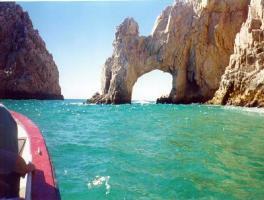 Land's End, Baja California |
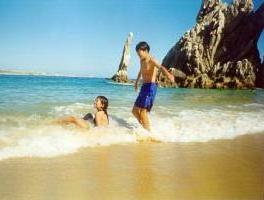 Swimming and snorkeling at Land's End |
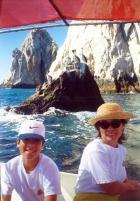 Take the glass bottom boat tour |
| The Cabo (cape) area is not much more than a destination for sun worshippers and beach combers, but it's not bad. The beach at Land's End is one of the most beautiful beaches I've ever seen. The sand bisects rocky granite crags between the Pacific to the Sea of Cortez. On the west, you can surf bone-crushing breakers. On the east, you can swim and snorkel in tranquil flat waters. Most of the accommodations at the cape are newly built time shares and resort hotels. We stayed at the Pueblo Bonito Rose resort hotel. Beautiful location, good service, very comfortable. I would stay here again. | ||
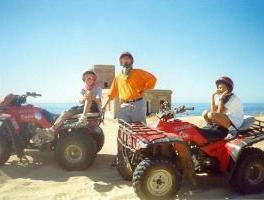 Exploring Baja by ATV |
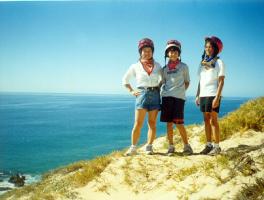 The big blue Pacific Ocean |
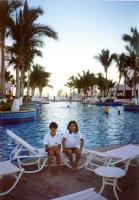 The pool at our hotel |
|
Some people like to spend their entire vacations lying in the sun doing nothing. Not us. After three days
in this beach paradise, we hopped a plane back to Mexico City, spent the night at the very convenient
Airport Hilton and then took another flight
east to Merida the next morning. Incidentally, the Mexico City airport is huge, the lines are long
and there's always lots of traffic to and from the airport. Staying overnight at the airport hotel
is a good strategy if you have an early departure the next morning.
We rented a car at the Merida airport and drove 100 km east via tollroad to the Mayan ruins at Chichén Itzá. |
||
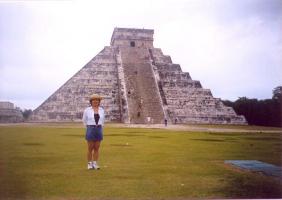 |
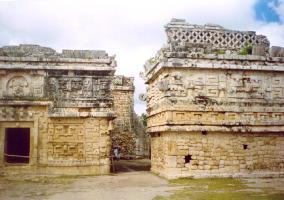 |
|
If you only have time to visit one Mayan ruin, see this one. Chichén Itzá was the last center
of power of the Mayan civilization. The buildings represent 1000 years of architecture and are beautifully
restored. There's a dramatic sound and light show at 7:00pm every evening. Unlike nearby
Uxmal, you can still
climb the main pyramid. The only Mayan site that is more exciting is probably
Palenque -- which I've never seen. Unfortunately,
it's 800 km south of here in Chiapas and we didn't have time to go there. Maybe next time.
When you visit Chichén Itzá, stay at Hacienda Chichén. This is my favorite place to stay in all of Mexico. The management and staff is gracious and friendly. The daily fare at their patio restaurant is excellent and the special Mayan feast they served for Christmas dinner was unforgettable. And, you're only a three minute walk from the ruins. There are four short trips worth taking from Chichén Itzá:
|
|
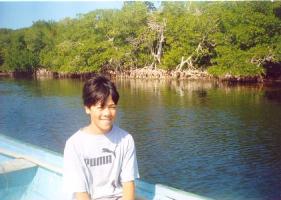 |
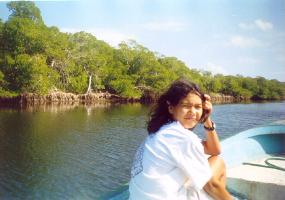 |
| Touring the mangrove swamps of Rio Lagartos National Park | |
|
After 3 relaxing days at Chichén Itzá, we drove 150 km east to the Mayan Riviera.
This is a built-up resort area with huge hotel complexes in
Cancun and Cozumel.
We avoided most of the crowds by staying at Playa del Carmen,
a fun beach town full of lively of bars and restaurants. A travel agent set us up at the Porto Real Resort,
which was OK but I wouldn't enthusiastically recommend it. Too American. If we go again, we'd look to rent
a villa a little farther south at Akumal.
This area attracts millions of English speaking tourists every year to the beautiful beaches and reefs full of tropical fish. You should also check out these local attractions: Xcaret - A family-oriented ecopark. Be sure to visit the sea turtle hatchery, the butterfly garden, the tropical bird paradise and the museum with detailed scale models of all the Mayan ruins. Through the middle of the park is a water-filled tunnel that allows you to swim (or float) from one end of the park to the other. In the evening, there's a wonderful show which includes a Mayan ball game and a colorful musical review. For an extra fee, you can swim with dolphins. |
||
 |
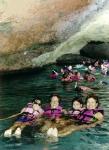 |
 |
| Cave diving - There are over 350 km of submerged limestone caves in this part of Mexico. Some of these caves are open on a limited basis to the public for snorkeling and scuba diving. Swimming in crystal clear water through forests of stalactites is a once-in-a-lifetime experience. As far as I know, this is the only place in the world where you can do this. We took the Tak Be Ha Cavern Snorkel Tour with Hidden Worlds Dive Center and were quite satisfied. | |
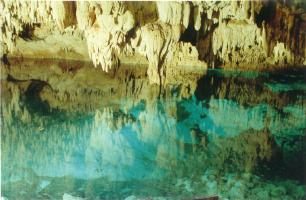 |
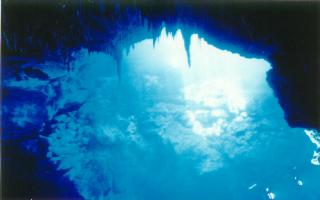 |
Tulum - This is the only Mayan sea port.
Heavily fortified with walls, it overlooks a deep harbor with delightful coral reefs not far away.
A good day trip.
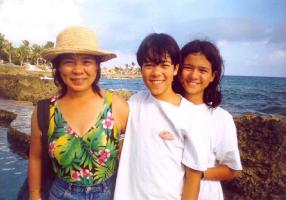 Xel-ha - Operated by the same concession that runs Xcaret, this is another beautiful nature park. As with Xcaret, you can swim with dolphins here and see recently hatched sea turtles. There are fewer restaurants or cultural performances and more emphasis on being surrounded by nature. |
|
|
After only three days it was time to leave Playa del Carmen and head back to Mexico City.
On the way back to the Merida airport, we stumbled onto an interesting item of note. About 100 years ago,
a Japanese doctor named Hideyo Noguichi came to Merida to do research on tropical diseases. He was
successful in creating a vaccine for yellow fever. On the pretty tree-lined boulevard from downtown
Merida to the airport, you'll find his bronze statue and a medical institute named after him.
It's amazing what you can find when you keep your eyes open.
Back in Mexico City, we stayed at the Majestic Hotel in the very heart of the city overlooking the grand plaza, known as the Zocalo. This is a classic old-style hotel. There's a little man in the elevator who asks you what floor you want to go to. Be sure to have at least one meal at the romantic restaurant on the roof. You'll enjoy a fabulous view of the city. Next door is the Gran Hotel which looks great, too. In any case, if you want to get a feel for what Mexico City is really like, stay at either of these two hotels. Be sure to ask for a room with a view of the zocalo. From our hotel on the zocalo, we spent a day visiting these three amazing sites on foot: |
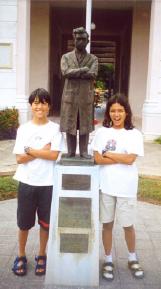
|
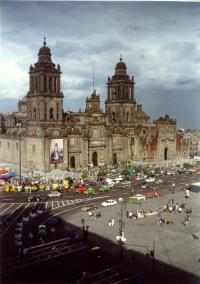
|
The Metropolitan Cathedral is one of the world's largest cathedrals. It was originally built in 1525 using rock from demolished Aztec temples. It was razed in 1573 to make way for the present structure which took 240 years to complete. The church has 14 chapels along its side aisles. At the end of the nave behind the main altar is an extravagantly gilded wooden Churrigueresque altarpiece, the largest gold-plated carving in the world. The 1985 earthquake caused significant damage to the old cathedral and it is now visibly tilting and sinking into the soft mud on which it is built. See this cathedral while it is still standing! |
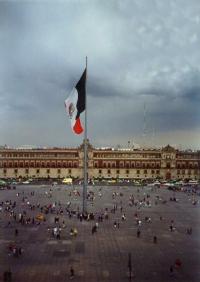
|
The National Palace
is the administrative center
of Mexico. Admission is free. Walk upstairs to the second level to see a marvelous collection of
Diego Rivera murals
depicting the history of Mexico.
The picture to the left shows the National Palace as seen from the balcony of our hotel. One reason to get a room with a view is so that you can witness the flag raising and lowering ceremonies that occur twice a day. |
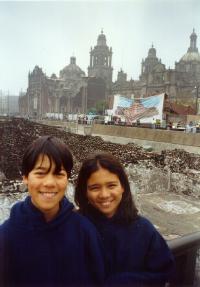
|
The Templo Mayor and its museum.
In 1978 during construction of a subway station, the shovel of a worker accidentally struck a
buried 8-ton stone carving of the Aztec moon god. This accident let to the discovery of the main
pyramids of the original Aztec capital and ceremonial center.
For about $3, you can tour the on-going excavation of the Aztec pyramid. The museum is excellent. Though the signs are all in Spanish, English speaking guides are available. Here are Daniel and Mikka in the middle of the excavation site, with the Metropolitan Cathedral in the background. Really quite incredible and convenient to have all these great sites within sight of each other. All in all, we found Mexico to be a wonderful, colorful and exciting place ... and a memorable place to spend Christmas! |
If this trip looks like fun, you might want to read about our other adventures.